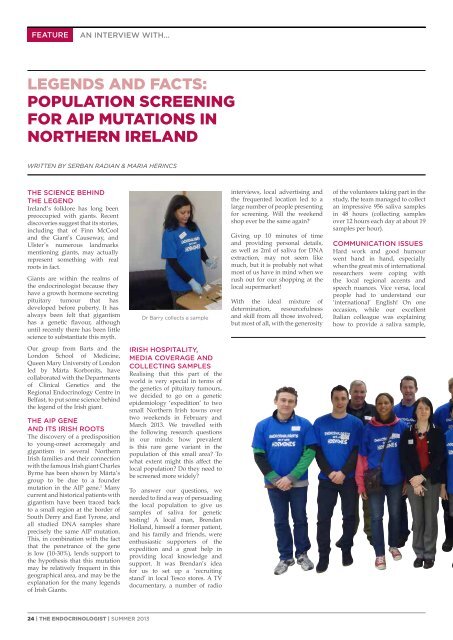Howard Jacobs
Howard Jacobs
Howard Jacobs
You also want an ePaper? Increase the reach of your titles
YUMPU automatically turns print PDFs into web optimized ePapers that Google loves.
FEAtURE<br />
AN INtERVIEW WItH...<br />
LEGENDS AND FACTS:<br />
POPULATION SCREENING<br />
FOR AIP MUTATIONS IN<br />
NORTHERN IRELAND<br />
WRITTEN BY SERBAN RADIAN & MARIA HERINCS<br />
THE SCIENCE BEHIND<br />
THE LEGEND<br />
Ireland’s folklore has long been<br />
preoccupied with giants. Recent<br />
discoveries suggest that its stories,<br />
including that of Finn McCool<br />
and the Giant’s Causeway, and<br />
Ulster’s numerous landmarks<br />
mentioning giants, may actually<br />
represent something with real<br />
roots in fact.<br />
Giants are within the realms of<br />
the endocrinologist because they<br />
have a growth hormone secreting<br />
pituitary tumour that has<br />
developed before puberty. It has<br />
always been felt that gigantism<br />
has a genetic flavour, although<br />
until recently there has been little<br />
science to substantiate this myth.<br />
Our group from Barts and the<br />
London School of Medicine,<br />
Queen Mary University of London<br />
led by Márta Korbonits, have<br />
collaborated with the Departments<br />
of Clinical Genetics and the<br />
Regional Endocrinology Centre in<br />
Belfast, to put some science behind<br />
the legend of the Irish giant.<br />
THE AIP GENE<br />
AND ITS IRISH ROOTS<br />
The discovery of a predisposition<br />
to young-onset acromegaly and<br />
gigantism in several Northern<br />
Irish families and their connection<br />
with the famous Irish giant Charles<br />
Byrne has been shown by Márta’s<br />
group to be due to a founder<br />
mutation in the AIP gene. 1 Many<br />
current and historical patients with<br />
gigantism have been traced back<br />
to a small region at the border of<br />
South Derry and East Tyrone, and<br />
all studied DNA samples share<br />
precisely the same AIP mutation.<br />
This, in combination with the fact<br />
that the penetrance of the gene<br />
is low (10-30%), lends support to<br />
the hypothesis that this mutation<br />
may be relatively frequent in this<br />
geographical area, and may be the<br />
explanation for the many legends<br />
of Irish Giants.<br />
24 | THE ENDOCRINOLOGIST | SUMMER 2013<br />
Dr Barry collects a sample<br />
IRISH HOSPITALITY,<br />
MEDIA COVERAGE AND<br />
COLLECTING SAMPLES<br />
Realising that this part of the<br />
world is very special in terms of<br />
the genetics of pituitary tumours,<br />
we decided to go on a genetic<br />
epidemiology ‘expedition’ to two<br />
small Northern Irish towns over<br />
two weekends in February and<br />
March 2013. We travelled with<br />
the following research questions<br />
in our minds: how prevalent<br />
is this rare gene variant in the<br />
population of this small area? To<br />
what extent might this affect the<br />
local population? Do they need to<br />
be screened more widely?<br />
To answer our questions, we<br />
needed to find a way of persuading<br />
the local population to give us<br />
samples of saliva for genetic<br />
testing! A local man, Brendan<br />
Holland, himself a former patient,<br />
and his family and friends, were<br />
enthusiastic supporters of the<br />
expedition and a great help in<br />
providing local knowledge and<br />
support. It was Brendan’s idea<br />
for us to set up a ‘recruiting<br />
stand’ in local Tesco stores. A TV<br />
documentary, a number of radio<br />
interviews, local advertising and<br />
the frequented location led to a<br />
large number of people presenting<br />
for screening. Will the weekend<br />
shop ever be the same again?<br />
Giving up 10 minutes of time<br />
and providing personal details,<br />
as well as 2ml of saliva for DNA<br />
extraction, may not seem like<br />
much, but it is probably not what<br />
most of us have in mind when we<br />
rush out for our shopping at the<br />
local supermarket!<br />
With the ideal mixture of<br />
determination, resourcefulness<br />
and skill from all those involved,<br />
but most of all, with the generosity<br />
of the volunteers taking part in the<br />
study, the team managed to collect<br />
an impressive 956 saliva samples<br />
in 48 hours (collecting samples<br />
over 12 hours each day at about 19<br />
samples per hour).<br />
COMMUNICATION ISSUES<br />
Hard work and good humour<br />
went hand in hand, especially<br />
when the great mix of international<br />
researchers were coping with<br />
the local regional accents and<br />
speech nuances. Vice versa, local<br />
people had to understand our<br />
‘international’ English! On one<br />
occasion, while our excellent<br />
Italian colleague was explaining<br />
how to provide a saliva sample,


